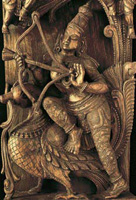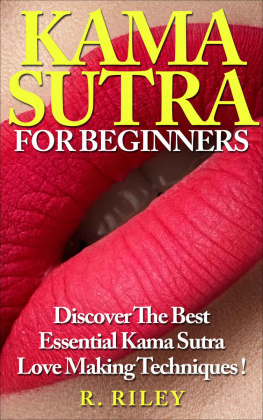
The exuberant Rajput prince embraces his beloved and plays with her feet.

Shiva and Parvati share affectionate moments as their sons Ganesh, the elephant god and Kartikeya are engrossed in their own activities and the tiger and Nandi, the bull laze around.

ACKNOWLEDGEMENTS
The Editor and the Publisher of Brijbasi Art Press Ltd. would like to thank the collectors for the generous use of the photographs of the unique paintings and pieces of sculpture reproduced in this book.
In particular, they wish to express their gratitude to Madame Florence, M. de Surmont, Shri J. P. Goenka, Rt. Hon. David Salman, Suresh K. Neotia, Gaylord Hoftizer, Michael Postel, Mrs Fiammeta Rossi, Mrs Sunita Pitamber, Gurappa Shetty, late David Abraham, Volkar Schafer & Michael Suessur, N. Boman Behram (heirs), Shailender M. Hem Chand, Mrs Anjolie Ella Menon, Anna Maria John, David Murdant May, Dr Daljeet Singh, Yannis Sarzetakis, Prof. Klaus Schleusener, Dr Peter Berghaus, Geo P. Bickford, late D. Langhammer.
Due recognition also goes out to the Archaeological Survey of India, New Delhi; Departments of Archaeology of the State Governments of Karnataka, Kolkata, Madhya Pradesh, Maharashtra; The National Museum, New Delhi; The Indian Museum, Kolkata; Bharat Kala Bhavan, Varanasi; Meenakshi Temple Museum, Madurai; the museums of Kabul, Afghanistan; Lahore, Pakistan; Mathura; Govt. Museums of Chandigarh, Gwalior, Chennai; the Ashutosh Museum, University of Kolkata (Prof. D. P. Ghosh); the M. C. Mehta Collection, Ahmedabad, the Dacca Museum, Bangla Desh.
The photographic archives of L. S. D. G. (Lance Dane & Satish Gupta) are the main source of the photographs reproduced here. If there is any change in the present location of any of the images, they would be pleased to revise the due recognition.

A young nayika waits anxiously and yearns for her lover.

The amazingly attractive nayika in a flowing skirt stretches one leg out and places the other on her lover's shoulder, then switches positions and continues to do so alternately in a posture described as splitting of a bamboo.

Mallinaga Vatsyayana lived sometime between the first and the sixth century A.D. in Benares and led the life of a religious student.
Preface

 very country's literature has among its treasures of the written word a number of works dealing especially with love. Everywhere too, the subject is dealt with in a different manner and from various points of view. This book is a comprehensive translation of the most authoritative work on love in Sanskrit literature - the Kama Sutra, Aphorisms on Love by Vatsyayana. Divided into seven books and thirty-six parts, the evidence concerning the date of the writing and the commentaries written on it are examined in the Introduction. Before commencing the translation in the books, however, a brief mention is made about similar works written by authors who wrote years after Vatsyayana, but who still quoted him as the chief guide to Hindu erotic literature.
very country's literature has among its treasures of the written word a number of works dealing especially with love. Everywhere too, the subject is dealt with in a different manner and from various points of view. This book is a comprehensive translation of the most authoritative work on love in Sanskrit literature - the Kama Sutra, Aphorisms on Love by Vatsyayana. Divided into seven books and thirty-six parts, the evidence concerning the date of the writing and the commentaries written on it are examined in the Introduction. Before commencing the translation in the books, however, a brief mention is made about similar works written by authors who wrote years after Vatsyayana, but who still quoted him as the chief guide to Hindu erotic literature.

Rati Devi, wife of Kama takes aim with her arrow of love. Such wood sculpture was used for decorative purposes in temple rathas, chariots.
RATIRAHASYA (Secrets of Love) by Kokkoka
Kokokka, a poet, composed the Ratirahasya to please someone called Venudutta, who was perhaps a king. Writing his own name at the end of each part of the book, he addressed himself as siddha patiya pandita - an ingenious man among learned men. His work was translated into Hindi long ago, and in the translation, he was referred to as Koka. With this abbreviated form of his name replacing his full name in other languages in India, the book and the subject began to be popularly called Koka Shastra, Doctrines of Koka, which is identical with the Kama Shastra, Doctrines of Love.
The Ratirahasya comprises nearly eight hundred verses, and is divided into fifteen parts called Pachivedas. Some of the subjects dealt with in this work are not to be found in Vatsyayana's translation, such as the four classes of women: the padmini, chitrini, shankhini and hastini; as also the enumeration of the days and hours on which the women of different classes were stimulated towards love. Kokkoka claimed that his knowledge of these subjects was garnered from the wisdom of Gonikaputra and Nandikesvara, both of whom have been mentioned by Vatsyayana, but whose works are not now extant. It is difficult to fix a date or year in which the Ratirahasya was composed. It can, however, be safely presumed that it was written after Vatsyayana's tome, and was prior to other works on the subject that are still extant. Vatsyayana, himself, referred to ten authors whose work on the subject he had consulted, but none of which is extant, and Kokkoka's name does not figure among them. This leads to the logical conclusion that Kokkoka wrote after Vatsyayana, else, Vatsyayana would surely have made mention of him with the others he referred to.

Nandi, bull companion of lord Shiva is said to be the first formulator of the Kama Shastras or rules of love that had one thousand chapters.

Shiva, is one of the major gods of the Hindu pantheon and forms with Brahma and Vishnu the great triad of Hindu deities.
PANCHASAYAKA (Five Arrows) by Jyotirisvara
Jyotirisvara, the author of Panchasayaka, was the most celebrated poet, the keeper of the treasure of the sixty-four arts, and the best teacher of the rules of music. He said that he composed the Panchasayaka after reflecting upon the aphorisms of love as revealed by the gods, and studying the opinions of Gonikaputra, Muladeva, Babhravya, Ramtideva, Nandikesvara and Kshemendra. None of these appear to be in existence now. His work contains nearly six hundred verses, divided into five parts called sayakas, or arrows.
SMARAPRADIPIKA (Light of Love) by Gunakara
The author of the Smarapradipika
Next page



















 very country's literature has among its treasures of the written word a number of works dealing especially with love. Everywhere too, the subject is dealt with in a different manner and from various points of view. This book is a comprehensive translation of the most authoritative work on love in Sanskrit literature - the Kama Sutra, Aphorisms on Love by Vatsyayana. Divided into seven books and thirty-six parts, the evidence concerning the date of the writing and the commentaries written on it are examined in the Introduction. Before commencing the translation in the books, however, a brief mention is made about similar works written by authors who wrote years after Vatsyayana, but who still quoted him as the chief guide to Hindu erotic literature.
very country's literature has among its treasures of the written word a number of works dealing especially with love. Everywhere too, the subject is dealt with in a different manner and from various points of view. This book is a comprehensive translation of the most authoritative work on love in Sanskrit literature - the Kama Sutra, Aphorisms on Love by Vatsyayana. Divided into seven books and thirty-six parts, the evidence concerning the date of the writing and the commentaries written on it are examined in the Introduction. Before commencing the translation in the books, however, a brief mention is made about similar works written by authors who wrote years after Vatsyayana, but who still quoted him as the chief guide to Hindu erotic literature.

